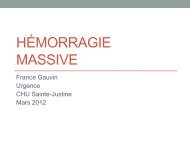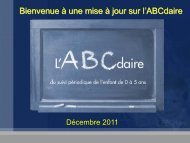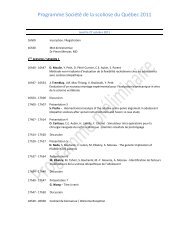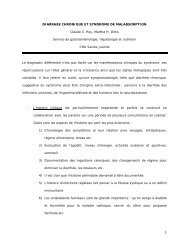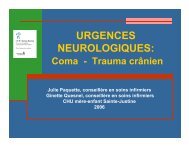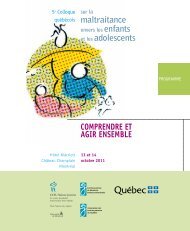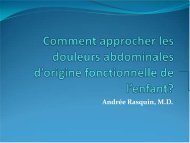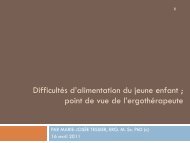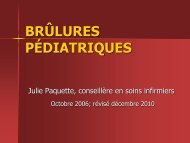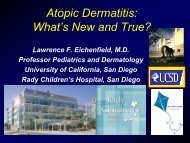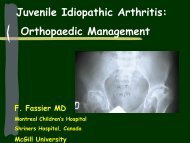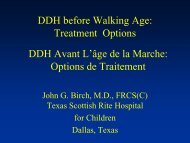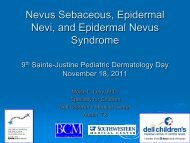Infantile Hemangioma - CHU Sainte-Justine - SAAC
Infantile Hemangioma - CHU Sainte-Justine - SAAC
Infantile Hemangioma - CHU Sainte-Justine - SAAC
- No tags were found...
Create successful ePaper yourself
Turn your PDF publications into a flip-book with our unique Google optimized e-Paper software.
<strong>Infantile</strong> <strong>Hemangioma</strong>s:Approach and UpdateIlona J. FriedenProfessorDermatology and PediatricsUniversity of California, San Francisco
Consultant Pierre FabreDermatology andChair DSMB Hemangiol TrialI will not be discussing any results from thistrial nor draw conclusions from it.I will be discussing non-FDA approvedmedications
Overview• Which hemangiomas need treatment• Natural History• When to treat – new information on growth• When hemangiomas go away• Treatment with beta-blockers• Meta-analysis of Rx with propranolol in ~ 1200 pts.• Consensus guidelines for propranolol use• Topical beta-blockers
<strong>Infantile</strong> <strong>Hemangioma</strong> (IH):A Unique Vascular Tumor• Characteristic naturalhistory-- growth thenspontaneous involution• Unique demographicfeatures: ↑ Females,Caucasian race, preterminfants, twins, advancedmaternal age• NOT neoplasm of“normal” cutaneouscapillaries
How do we decidewhich hemangiomasto worry about andwhich need treatment?Pattern, location, and thickness
<strong>Hemangioma</strong> PatternsLocalized and Segmental• Segmental: Broad anatomic region or recognizeddevelopmental unit (such as the entire ear)• Localized: Confined spatially, often appear to arisefrom central focal point
Risk of Segmentals• Segmental hemangiomas much morelikely to experience complications• Facial segmental hemangiomas are muchmore likely to require systemic treatment• Segmentals have much higher risk ofextra-cutaneous morbidities i.e. PHACEsyndrome and LUMBAR syndromeHaggstrom et al. Pediatrics 2006 Sep;118(3):882-7
High-Risk for Disfigurement• Face > 0.5 cm• Nasal tip• Perioral• Glabella• Ear• Eyebrow• Thick/exophytic areasnot easily covered byclothingHaggstrom A et al. Arch Dermatol. 2012 Feb;148(2):197-202.
Residual skin changes inuntreated hemangiomas:• Study of 97 patients in tertiary care setting:Recalled for examination• Residual lesions were present in 69%•Superficial hemangiomas significantlymore skin residua than deep (74% vs25% O.R. 8.4)•~ half were permanent skin changesBauland CG et al. Plast Reconstr Surg 2011;127:1643
Not Just Which<strong>Hemangioma</strong>s…But When
Very Early Growth:Birth 1 year 2years 3years 4years 5 Years
Early Growth• 80% of infantile hemangioma (IH) growthoccurs by age 3 mos• 80% of IHs have completed growth by age 5months• Growth characteristics before 3 monthshard to study because most infants presentlater than 3 monthsChang et al. Pediatrics 2008;122:360-7
Very Early Growth:Study usingparents’photos tolearn moreabout thispart of thecurveTollefson M and Frieden IPediatrics 2012;130:e314-20Birth 1 year 2years 3years 4years 5 Years
Results
Timing of Initiation of Treatment~1 month old3 months old
What about timing of involution?• 81 patients - 88%needed reconstivesurgery for residualdeformity.• Involution ceased at amedian age of 36months• 92% of IH completedinvolution by 4 yearsCouto et al. Plast Reconstr Surg.Online early 5/9/12
Reevaluationat age 3 to 4 years• “If there is a problem, we’ll take care of it beforeKindergarten”• Can gauge whether permanent skin changesmore easily• This timing also fits with knowledge of cognitivedevelopment
<strong>Hemangioma</strong> Treatment pre-2008• Most commonly NO TREATMENT• Systemic agents: Corticosteroids, interferon alfa,vincristine• More localized modalities of treatment• Intralesional and topical steroids• Pulsed dye laser• Cryotherapy• Imiquimod• Various other (cryotherapy, imiquimod)• Modest efficacy, best in growth phase
Propranolol as RxLéauté-Labrèze C et alJune 12, 2008358:2649-2651
Beta-blockers for <strong>Infantile</strong><strong>Hemangioma</strong>s: 4 years later• More than 240 articles published• Systematic Review 41 case series with≥ 10 patients: Total of 1264 patients• 28% received prior Rx, most commonlyoral prednisolone• Propranolol initiated mean age of 6.6 mos,mean dose of 2.1 mg/kg/day• Mean duration Rx 6.4 months
Results of Systematic Review• Response rate was 98% (range 82 – 100%)• Response rates ~ comparable irrespectiveof anatomic sites e.g. periorbital, airway, etc.• Rebound growth in 17%• AE rate ~ 3 to 5%, with sleep changes andacrocyanosis being most common• Serious AEs rareMarqueling et al. Poster Soc Ped Dermatol July 2012
Another Systematic Review:Steroids vs. Propranolol• Review of literature was conducted 1965 – 2012• 16 studies (2,629 patients) vs 25 studies (795 patients)• Overall efficacy rate for systemic steroids was 71%compared to 97% for propranolol (p
Propranolol ConsensusGuidelinesDrolet et al. Pediatrics 2012 In Press
Inpatient or Outpatient?• Inpatient hospitalization suggested for thefollowing• Infants < 8 weeks of gestationally corrected age• any age infant with inadequate social support,• any age infant with comorbid conditions affecting thecardiovascular system, the respiratory system (e.g. airwayhemangiomas, etc.• Outpatient initiation with monitoring can beconsidered for the following:• Infants/toddlers over 8 weeks of age with adequatesocial support and without significant comorbidities
Monitoring – All Patients• The peak effect of oral propranolol on HR and BP is 1 to 3hours after administration.• Patients should be monitored with HR and BP measurementat baseline and at 1 and 2 hours after receiving the initial dose• Repeat with significant dose increase (>0.5 mg/kg/day),including at least 1 set of measurements after the target dosehas been achieved.• If HR and BP are abnormal child should be monitored untilthe vitals normalize.• Dose response is usually most dramatic after the first dose;• no need to repeat for same dose unless very young or hascomorbid conditions affecting CV or resp. systems• HR easier to accurately obtain than BP.
Hypoglycemia• Routine glucose testing not recommended• Risk of hypoglycemia is age-dependent and beginsafter 8 hours of fasting in children 0-2 years of age• Infants 4 months every 6-8 hours• Propranolol should be discontinued duringintercurrent illness, especially in the setting ofrestricted oral intake.
Caveat• This information is based on current knowledge• Should be considered provisional i.e. subject torevision.
How do β-blockers work?• We don’t know!• My 3 favorite theories:• Decreasing renin production• Regression via HIF-1α-mediated inhibition ofVEGF-A• Inhibition of migration of endothelial progenitorcells to hemangioma sitesItinteang T et al. Plast Reconstr Surg. 2011;128:499-507Chim H et al.Ann Surg. 2012;256:146-56Zou H-X et al. Cardiovasc Pathol 2012 Online early
What about TopicalBeta-Blockers?
Topical Beta Blockers• 20 articles since February 2010: ~175 patientsreported• Nearly all retrospective: Largest series- 73 patients• Mostly timolol ophthalmic solution but 2 reportsused compounded propranolol• Varied concentrations and frequency• Timolol – most 0.5% GFS formulation but others• Duration usually 3 mos or moreChakkittakandiyil A et al. Pediatr Dermatol. 2012 ;29:28-31
Topical Beta-Blockers:Experience in past 2.5 years• Encouraging results• Eyelid lesions do particularly well• Self-selection for more superficial and smallerhemangiomas• Well-tolerated: No significant toxicity reportedto date• Relatively inexpensive• Should primary care physicians use as initial Rx(with or without referral)?
Timolol:Anything to Worry about?• 4-10x more potent than propranolol• Topical application so no first-pass metabolism• Reports of severe adverse events (AEs) withintraocular administration• Detectable in urine and in low levels in blood• Too soon to be confident re: AEs but none todate• Prudent to limit to 1-2 drops per treatmentMcMahon et al. Pediatr Dermatol 2012; 29:127-30



